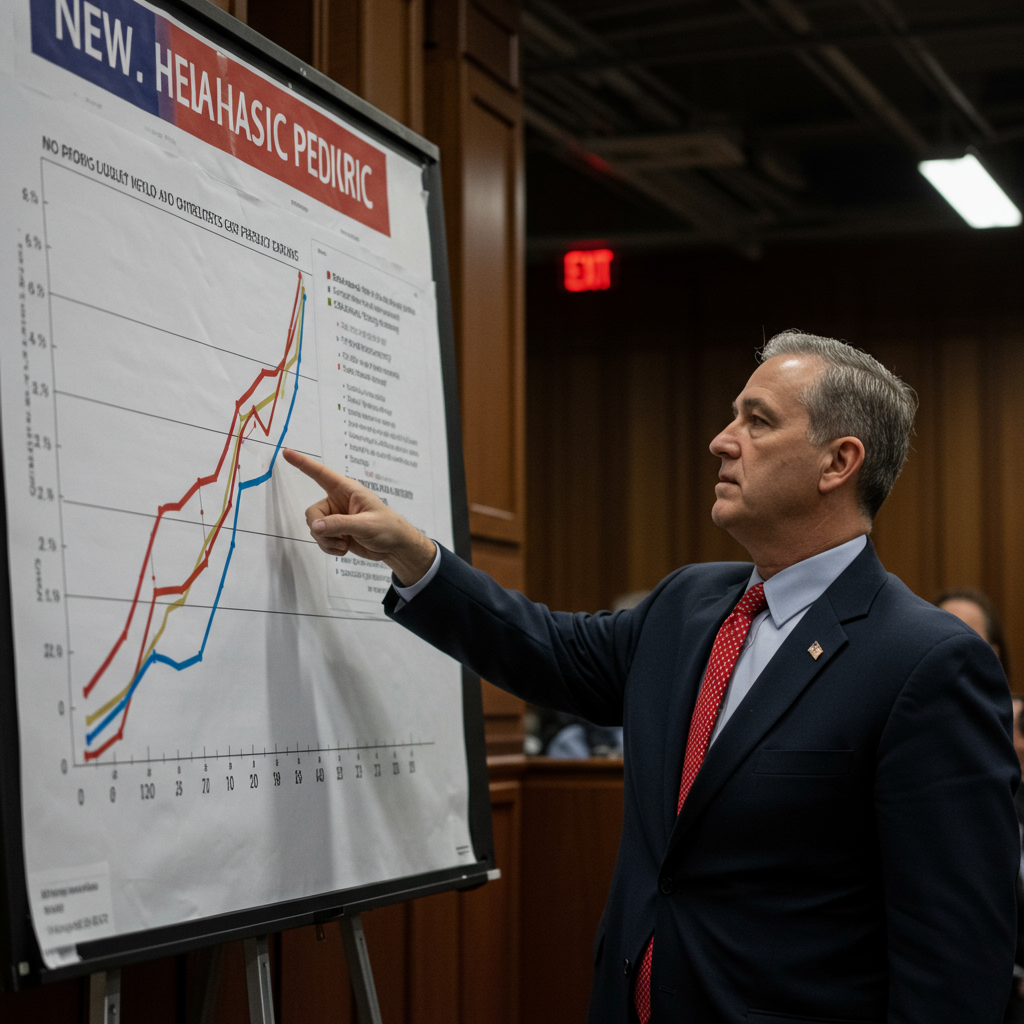The United States experienced an alarming surge in influenza-associated pediatric deaths during the 2024-25 season, marking it as one of the most devastating flu seasons for children in recent history. A new report reveals a sobering 280 child deaths, making it the highest toll since national surveillance began in 2004, surpassed only by the 2009-10 H1N1 pandemic. This critical public health alert underscores persistent vaccination gaps and the urgent need for heightened awareness among parents and healthcare providers regarding the severe and often rapid progression of influenza in children.
Unprecedented Severity: A Closer Look at the 2024-25 Pediatric Flu Deaths
The 2024-25 influenza season stands out as the first “high-severity” season since 2017-18, leaving a profound impact on child health across the nation. The Centers for Disease Control and Prevention (CDC) report details a national mortality rate of 3.8 deaths per 1 million children under 18 years old. Youngest children were disproportionately affected, with infants under six months facing the highest mortality rate at 11.1 deaths per 1 million. This tragic rise in pediatric flu deaths highlights the potent threat influenza poses to even the youngest and seemingly healthiest individuals.
The data further reveals crucial demographic insights. While White children accounted for the largest percentage of deaths (42%), Black or African American children experienced the highest mortality rate at 5.8 per 1 million. The median age at death was seven years, with a significant 61% of deaths occurring in children younger than nine. Females also showed a higher mortality rate compared to males, indicating complex vulnerabilities. The predominant strains causing these deaths were Influenza A viruses (86%), with both A(H1N1)pdm09 and A(H3N2) viruses contributing almost equally to the tragic outcomes.
The Critical Role of Vaccination: A Missed Opportunity for Protection
A striking and consistent finding across multiple analyses of the 2024-25 influenza season is the alarmingly low vaccination rate among the children who succumbed to the illness. A staggering 89% of vaccine-eligible pediatric decedents were not fully vaccinated against influenza. This figure represents a concerning increase from approximately 80% in previous seasons, underscoring a persistent and dangerous gap in routine public health protection.
Annual influenza vaccination is universally recommended for all individuals aged six months and older who do not have contraindications. Experts emphasize that immunization remains the single most effective strategy to lessen flu intensity, reduce hospitalizations, and prevent severe complications and death. The data unequivocally demonstrates that improved child flu vaccination rates are paramount to safeguarding pediatric lives, particularly for the upcoming 2025-26 season. Healthcare providers, including pharmacists, are urged to proactively counsel families on the critical importance of timely vaccination.
Neurological Complications: A Silent Threat of Influenza
Beyond typical respiratory symptoms, the 2024-25 season brought an alarming surge in severe neurological complications in children, specifically influenza-associated encephalopathy (IAE) and its highly severe form, acute necrotizing encephalopathy (ANE). Clinicians noted unusual severity, including fatal cases, leading to a comprehensive CDC analysis that documented 109 pediatric IAE cases, with 37 confirmed as ANE. This represents the largest reported series of such cases in the U.S. to date.
What makes these complications particularly concerning is their potential to affect previously healthy children. Over half of the affected IAE and ANE patients had no prior underlying medical conditions. Neurological symptoms, such as sudden confusion, seizures, altered mental status, or loss of consciousness, often developed rapidly, typically within two days of the initial flu symptom onset. This swift progression underscores the need for immediate medical attention, even in children with seemingly mild initial symptoms.
The Devastating Impact of IAE and ANE
The severity of IAE and ANE cannot be overstated. Among the 109 reported IAE cases:
74% required admission to an Intensive Care Unit (ICU).
54% needed invasive mechanical ventilation.
19% ultimately died.
Children diagnosed with ANE faced even graver outcomes, with a harrowing 41% fatality rate. Furthermore, most ANE survivors experienced prolonged neurological deficits at hospital discharge, highlighting the long-term, debilitating consequences of this severe flu complication in children. Despite the aggressive nature of these conditions, only 16% of IAE patients and 13% of ANE patients had been vaccinated, once again emphasizing the critical role of vaccination in prevention. While antiviral therapies were often administered, treatment frequently began late, typically after hospitalization.
Beyond Vaccination: Recognizing Risk Factors and Rapid Deterioration
While vaccination is key, understanding other risk factors is also crucial. Approximately 56% of the children who died had at least one underlying medical condition. Neurologic conditions were the most frequently reported, accounting for 63% of those with comorbidities, often including developmental delays. However, it is essential to remember that influenza poses broad risks, and a significant proportion of deaths occurred in otherwise healthy children.
The clinical course leading to death was often rapid. The median interval from illness onset to death was just four days. Worryingly, nearly half of the pediatric deaths occurred either outside a hospital (22%) or in an emergency department (27%). Children who died in these settings typically experienced a significantly shorter median interval from illness onset to death (2-3 days) compared to those who died in a hospital (7 days). These children were also less likely to have received antiviral treatment, highlighting challenges in timely intervention and access to care. Common complications preceding death included shock or sepsis (50%), pneumonia (38%), and acute respiratory distress syndrome (28%). Bacterial co-infections, involving pathogens like Staphylococcus aureus and Streptococcus pneumoniae*, were documented in 41% of children who underwent sterile site testing.
Improving Surveillance and Clinical Vigilance
The 2024-25 season brought to light significant gaps in national surveillance systems, particularly concerning influenza-associated neurological complications. The lack of a standardized system means that severe, non-fatal outcomes of IAE and ANE may be undercounted. The CDC plans to integrate IAE and ANE monitoring into routine flu surveillance systems for the upcoming 2025-26 season, a crucial step toward better understanding the true burden of these conditions.
For clinicians, including primary care providers and emergency personnel, heightened vigilance is paramount. They must consider IAE in any child presenting with fever or respiratory illness who rapidly develops seizures, altered mental status, or decreased consciousness during flu season. Prompt initiation of antiviral therapy, as recommended by the CDC, is crucial for high-risk children, irrespective of laboratory confirmation. For parents and caregivers, recognizing sudden neurological signs as an urgent warning requiring immediate medical evaluation is life-saving.
Frequently Asked Questions
What specific neurological complications were linked to pediatric flu in 2024-25, and how severe were they?
The 2024-25 influenza season saw an alarming increase in influenza-associated encephalopathy (IAE) and acute necrotizing encephalopathy (ANE) in children. These conditions involve severe brain inflammation triggered by the flu, often affecting previously healthy children. Out of 109 IAE cases, 74% required ICU admission, 54% needed mechanical ventilation, and 19% died. ANE, a more severe form, had a 41% fatality rate, with most survivors experiencing long-term neurological deficits. Symptoms like seizures or altered mental status can develop rapidly after flu onset.
Why is annual influenza vaccination critical for children, especially after the 2024-25 season?
Annual influenza vaccination is critical because the 2024-25 season saw 280 pediatric flu deaths, the second-highest since 2004. A devastating 89% of vaccine-eligible children who died were not fully vaccinated, highlighting a clear protection gap. Vaccination significantly reduces a child’s risk of severe flu, hospitalization, and life-threatening complications like IAE and ANE. It’s the most effective preventative measure for all children aged six months and older to build immunity and safeguard against future severe pediatric flu deaths.
What urgent warning signs should parents and clinicians recognize for severe flu in children?
Parents should be highly vigilant for rapid deterioration, especially neurological symptoms, in children with flu-like illness. Urgent warning signs include sudden confusion, seizures, altered mental status, decreased consciousness, or rapid progression of fever and respiratory distress. The 2024-25 data showed nearly half of pediatric deaths occurred outside hospitals, often with rapid progression (2-3 days from onset to death). Clinicians must consider IAE in children with fever and neurological changes during flu season and initiate prompt antiviral treatment and supportive care.
A Call to Action for Future Seasons
The 2024-25 influenza season serves as a stark reminder that influenza is far from a benign illness, especially for children. The record number of pediatric flu deaths, combined with the surge in devastating neurological complications, underscores a critical public health challenge. Protecting children requires a multi-pronged approach: widespread annual influenza vaccination, heightened clinical vigilance, and increased parental awareness of both respiratory and severe neurological warning signs. The imperative to vaccinate all eligible children, improve surveillance, and ensure timely medical intervention is undeniable as we look towards mitigating the impact of future flu seasons in the United States.
Word Count Check: 1220




